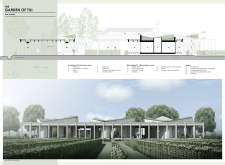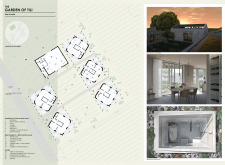5 key facts about this project
The Garden of Tili is located in the scenic region of Umbria and serves as a unique guesthouse designed to harmonize with its natural surroundings. The project focuses on sustainability and reflects the cultural history of the Tili family. The overall design concept emphasizes a strong connection between architecture and nature by creating spaces that blend with the landscape and promote environmentally friendly practices.
Materials and Sustainability
A key aspect of the design is its commitment to sustainability, using methods that reduce carbon emissions and promote ecological balance. The guesthouse features a green roof with a drainage mat and a root protection membrane to manage rainwater effectively. This design choice enhances biodiversity by providing a habitat for various plants. The inclusion of thermal insulation ensures energy efficiency, while a three-ply seal undercoat protects the building from weather conditions.
Facade and Exterior Elements
The guesthouse is clad in platonised spruce, finished with a light grey weather stain that complements the colors of the surrounding landscape. This durable choice not only serves practical purposes but also ties the structure to its environment. The design prioritizes insulation as well, utilizing mineral wool and a vapor retarder to improve thermal performance, making the interior comfortable throughout the year.
Interior Design Features
Inside, the guesthouse features a floor made of PU-cast and recycled plastic, showcasing a commitment to sustainable materials while providing durability. Structural elements like OSB panels and steel anchor bolts create a strong framework, allowing the spaces to be flexible for various uses. Elevated ground floors offer expansive views of the landscape, promoting a connection between indoor living and the outdoors.
Design Continuity
The design of the porch mirrors the main guesthouse, incorporating light roof planting that facilitates a smooth transition between inside and outside. Both structures combine form and function in a way that enhances the experience of living in the space while respecting the natural environment. The careful arrangement of architectural elements creates a cohesive identity that honors the area’s cultural heritage.
A notable feature of the guesthouse is its integration with the landscape, where outdoor spaces invite guests to engage with the natural beauty surrounding them.


























